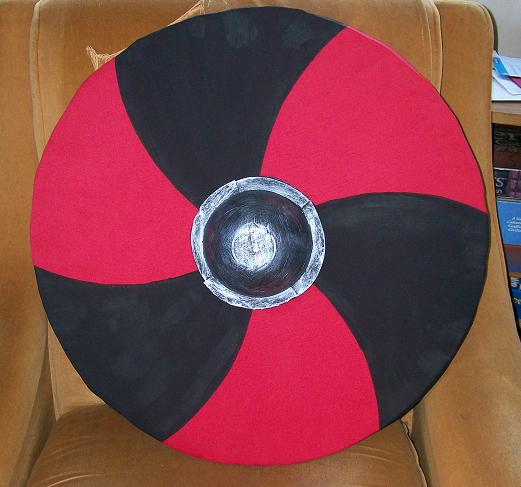The best places to get Corflute for FREE:
- nick the nearest “HOUSE SOLD” sign. Wait till it has a SOLD sticker on it or people will get upset.
If you don’t want to nick it:
- Go into a real estate agent and ask for any used signs.
- Bottle stores. They tend to have heaps.
I have also had luck getting foam mats for free from water parks that use foam mats for hydroslides. As long as you don’t mind having the edges a bit tattered.
Notes: Try to have the ‘white side out’ (sign side in) even when covering with fabric or painting it.
Putting foam on the inside edge of your shield is a good idea. Especially at the top and the bottom point. You won’t like getting your shield hit into your face, specially with staples etc in.
If you have spell scrolls you need to read often, try taping them to the back of your shield. Several of us did this in Mordavia.
Removable fabric covers!
1: Put your shield down on a piece of fabric. Add the width of the shield plus about 3in round the edge and cut out around it.
2: Get a long piece of very strong string/leather (or make a narrow fabric tube) which should be about about 30-60cm longer than the circumference of your shield.
3: EITHER: first fold over the edge of the fabric by about 1 in and sew leaving a pocket, leaving a hole at one point for the ties, and spend ages threading the string through it;
OR: lay the string round the edge of the fabric, fold the fabric over it, and sew trying like hell not to catch the string in the sewing machine as well (but no threading needed!)
4: Both ends of the string should stick out the hole of the pocket (top, bottom, or side - wherever you decided to put it - I favour the bottom especially if it’s pointed)
5: Paint the front side of the fabric with whatever cool design you want. (The important step!)
6: Put the shield down (straps up) on the back side of the shield cover, and pull the strings slowly while folding the cover edges over the shield. It should gather on the back of the shield. Pull the strings tight and tie a knot that you will be able to undo later. Tuck the ends under the fabric.
7: Now your shield is covered in fabric with a cool design on. Make more with different designs! use this to change a shield you’ve already painted a design on, that you want to keep for another game! Now your one shield can do for any larp you want, with any design you like, and moreover you will get used to the heft of it and not have to change to a different shield you don’t know well.

